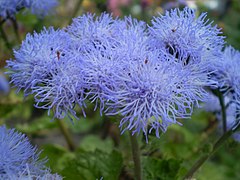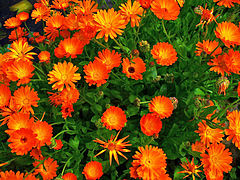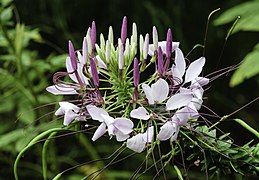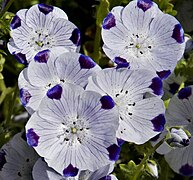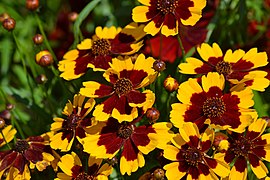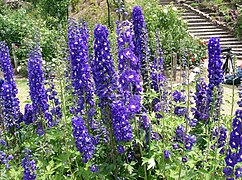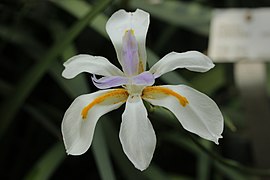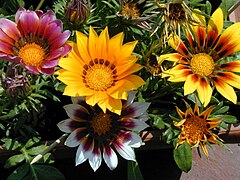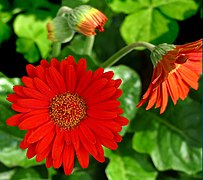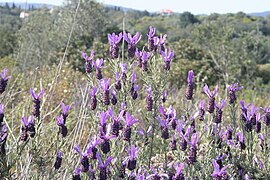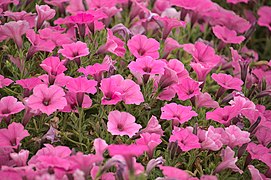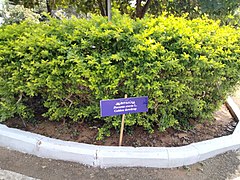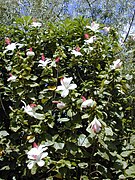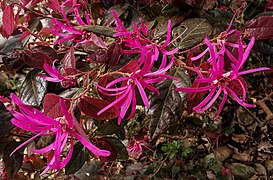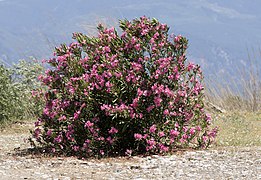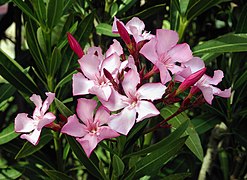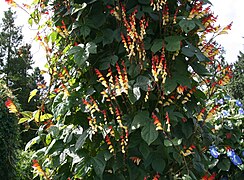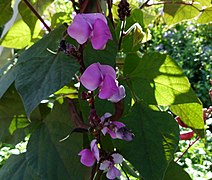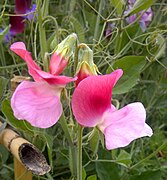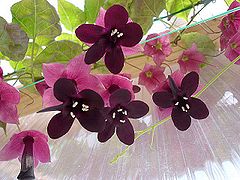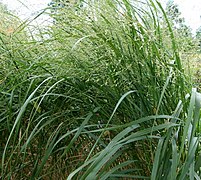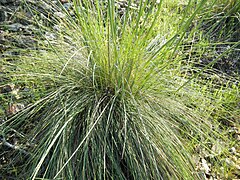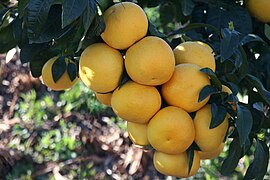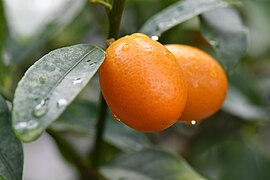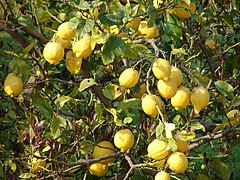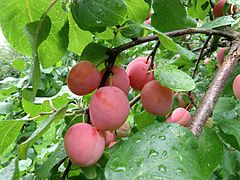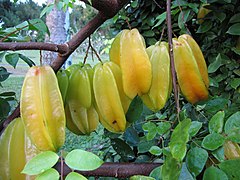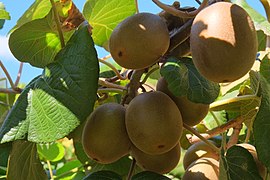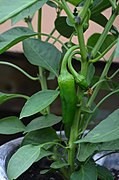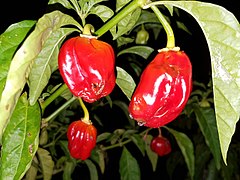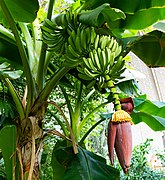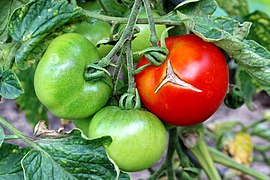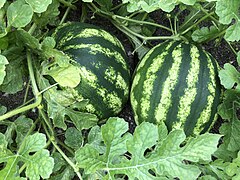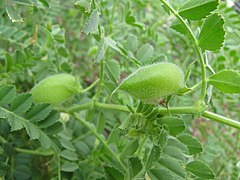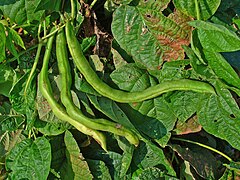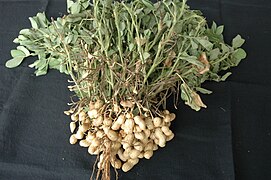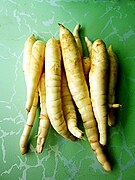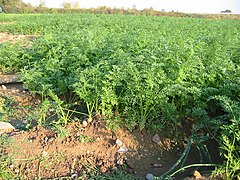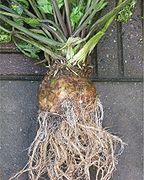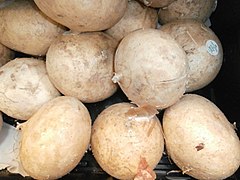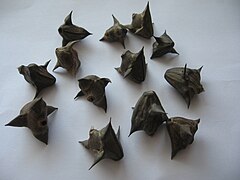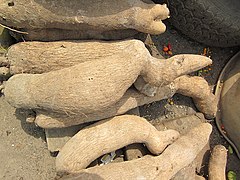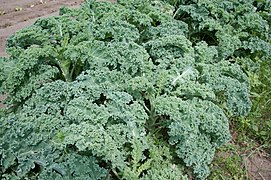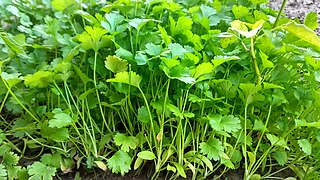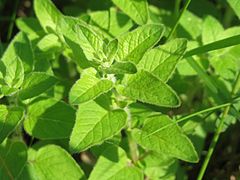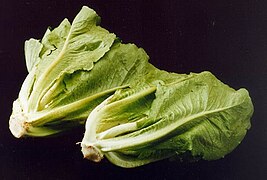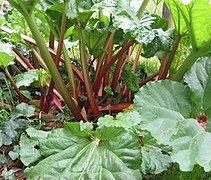Garden plants that thrive in USDA Plant Hardiness Zone 10
USDA plant hardiness zone 10 covers areas in Southern Florida, in Southern Texas, and in the Central and Southern Coast of California. This page includes only species of which seeds, cuttings, live plants, etc. are commonly commercially available.
Annotation: USDA plant hardiness zones describe temperature conditions only, not precipitation, soil conditions or other factors that are crucial for gardening. So, even if a species is identified as suited for a particular zone, it may require watering or other extensive care.
Flowers
[edit]Annuals
[edit]-
Ageratum houstonianum (Flossflower, Bluemink)
-
Amaranthus caudatus (Love-Lies-Bleeding)
-
Ammi visnaga (Bishop's flower, Toothpick Weed)
-
Calendula officinalis (Marigold)
-
Clarkia amoena (Farewell-to-Spring)
-
Collinsia heterophylla (Purple Chinese Houses)
-
Dimorphotheca sinuata (Cape Marigold)
-
Fagopyrum esculentum (Buckwheat)
-
Gilia capitata (Blue Gilia)
-
Gilia tricolor (Bird's-Eyes)
-
Helichrysum bracteatum (Straw Flower)
-
Lasthenia glabrata (Goldfields)
-
Layia platyglossa (Coastal Tidytips)
-
Moluccella laevis (Bells of Ireland)
-
Nemophila maculata (Five Spot)
-
Nemophila menziesii (Baby Blue Eyes)
-
Papaver rhoeas (Shirley Poppy)
-
Phacelia campanularia (Desert Bluebells)
-
Portulaca (Moss Rose)
-
Pycnosorus globosus (Billy Button, Craspedia globosa)
-
Tagetes erecta (African Marigold)
-
Tagetes patula (French Marigold)
-
Zinnia haageana (Mexican zinnia)
Perennials
[edit]Some of the following flowers that are annual plants in cooler climates, may be perennial in zone 10. The behavior may also depend on the variety.
-
Acanthus mollis (Bear's Breeches)
-
Antirrhinum majus (Snapdragon)
-
Agapanthus praecox (Lily of the Nile)
-
Celosia (Cockscombs, Woolflowers)
-
Centaurea cyanus (Bachelor Button)
-
Coreopsis tinctoria (Plains coreopsis, Tickseed, Golden Wave)
-
Delphinium (Larkspur)
-
Dianthus caryophyllus (Carnation)
-
Dietes iridioides (Wild Iris, African Iris)
-
Epilobium canum (California fuchsia, Zauschneria)
-
Eschscholzia californica (California Poppy)
-
Eustoma (Lisianthus)
-
Gaillardia (Blanket Flower)
-
Gaillardia pulchella (Indian Blanket)
-
Gypsophila elegans (Babys Breath)
-
Impatiens balsamina (Spotted Snapweed)
-
Iris missouriensis (Wild Blue Iris)
-
Lavandula dentata (French Lavender)
-
Lavandula stoechas (Spanish Lavender)
-
Limonium sinuatum (Sea Lavender, Statics)
-
Linum grandiflorum (Red Flax)
-
Linum lewisii (Lewis Flax, Blue Flax)
-
Lobelia erinus (Trailing Loberia)
-
Lomelosia stellata (Starflower)
-
Lupinus densiflorus (Yellow Lupine)
-
Lupinus succulentus (Arroyo Lupine)
-
Lychnis (Arkwright's Campion)
-
Malcolmia maritima (Virginia Stock)
-
Matthiola incana (Tenweeks Stock, Hoary Stock)
-
Mimosa pudica (Sensitive Plant)
-
Mirabilis jalapa (Four o'Clocks)
-
Nicotiana alata (Tobacco)
-
Osteospermum (African Daisy)
-
Oxalis pes-caprae (Bermuda Buttercup)
-
Penstemon palmeri (Palmer's Penstemon)
-
Romneya coulteri (Matilija Poppy)
-
Salvia (Sage)
-
Salvia pratensis (Meadow Sage)
-
Salvia spathacea (Hummingbird Sage)
-
Verbena (Common vervain)
-
Vinca (Periwinkle)
-
Viola tricolor (Pansy)
In California, Pride of Madeira (Echium candicans) and Treasureflowers (Gazania linearis) are considered to be potentially invasive species which may be advised not to plant.
Flowering shrubs and trees
[edit]-
Albizia julibrissin (Silktree, Mimosa Tree)
-
Arbutus unedo (Strawberry Tree)
-
Buddleja davidii (Butterfly Bush)
-
Callistemon viminalis (Bottlebrush)
-
Ceanothus (California Lilac)
-
Cercis occidentalis (Western Redbud, California Redbud)
-
Chaenomeles (Flowering Quince)
-
Erythrina (Coral Tree)
-
Duranta erecta (Golden dewdrop)
-
Lagerstroemia (Crape Myrtle)
-
Nerium oleander (Oleander)
-
Spathodea campanulata (African Tulip Tree)
-
Tecoma stans (Yellow Trumpetbush)
Hardiness zone 10 may be too warm for: Azalea (zone 3–9), Flowering Cherry (5–8), Forsythia (4–9), and Rhododendron (4–8), among others.
Flowering plants that grow well on a trellis
[edit]-
Billardiera heterophylla (Sollya heterophylla)
-
Bougainvillea can also be grown as a shrub
-
Clerodendrum (Glorybower, Bleeding Heart Vine) can also be grown as a shrub
-
Cobaea scandens (Cup and Saucer Vine)
-
Gelsemium sempervirens (Carolina Jessamine)
-
Ipomoea × multifida (Cardinal Climber)
-
Ipomoea alba (Moonflower)
-
Ipomoea lobata (Firecracker Vine)
-
Ipomoea purpurea (Morning Glory)
-
Ipomoea tricolor (Mexican Morning Glory)
-
Jasminum laurifolium (Angel Wing Jasmine) all jasmines can also be grown as a shrub
-
Jasminum mesnyi (Primrose Jasmine)
-
Jasminum nudiflorum (Winter Jasmine)
-
Jasminum officinale (Common Jasmine)
-
Jasminum sambac (Arabian Jasmine)
-
Jasminum polyanthum (Pink Jasmine)
-
Lablab purpureus (Hyacinth Bean)
-
Lathyrus odoratus (Sweetpea)
-
Lonicera sempervirens (Trumpet Honeysuckle, Coral Honeysuckle)
-
Mandevilla (Rock Trumpet)
-
Passiflora (Passionfruit)
-
Phaseolus coccineus (Scarlet Runner Bean)
-
Rhodochiton atrosanguineus (Purple Bell)
-
Rosa (Rose) can also be grown as a shrub
-
Rudbeckia hirta (Black-Eyed Susan)
-
Senecio tamoides (Canary Creeper)
-
Stephanotis floribunda (Madagascar Jasmine)
-
Tecomaria capensis (Cape Honeysuckle)
-
Thunbergia grandiflora (Blue Sky Vine, Bengal Clockvine)
-
Trachelospermum jasminoides (Star Jasmine)
-
Tropaeolum majus (Nasturtium)
Hardiness zone 10 may be too warm for: Clematis (zone 4–9), most varieties of Honeysuckle (5–9), Hydrangea (3–9), Trumpet Vine (4–9), and Wisteria (5–9), among others.
Ornamental grasses
[edit]-
Agrostis nebulosa (Cloud Grass)
-
Andropogon gerardii (Big Bluestem)
-
Bouteloua dactyloides (Buffalo Grass)
-
Bouteloua gracilis (Blue Grama)
-
Calamagrostis × acutiflora (Feather Reed Grass)
-
Carex comans (New Zealand Sedge 'Frosted Curls')
-
Carex hachijoensis (Sedge Grass 'Evergold')
-
Carex testacea (Orange New Zealand Sedge Grass, Orange Sedge)
-
Cenchrus setaceus (Fountaingrass, Pennisetum setaceum)
-
Chasmanthium latifolium (Northern Sea Oats Grass)
-
Cortaderia selloana (Pampas Grass)
-
Elegia tectorum (Cape Rush Grass, Chondropetalum tectorum)
-
Festuca glauca (Blue Fescue)
-
Helictotrichon sempervirens (Blue Oat Grass)
-
Juncus effusus (Soft Rush)
-
Lagurus ovatus (Bunny Tail Grass)
-
Miscanthus sinensis (Chinese Silvergrass, Maiden Silvergrass)
-
Miscanthus sinensis 'Strictus' (Porcupine Grass, Zebra Grass)
-
Muhlenbergia capillaris (Pink Muhly Grass, Hairawn Muhly)
-
Muhlenbergia rigens (Deer Grass)
-
Nassella tenuissima (Mexican Feather Grass)
-
Ophiopogon japonicus (Mondo Grass)
-
Panicum virgatum (Switch Grass)
-
Pennisetum orientale (Chinese Fountain Grass)
-
Pennisetum purpureum (Elephant Grass)
-
Phalaris arundinacea (Red Canary Grass)
-
Schizachyrium scoparium (Little Bluestem)
-
Stenotaphrum secundatum (St. Augustine Grass)
-
Stipa gigantea (Giant Feather Grass)
Edibles
[edit]Fruit bearing trees
[edit]-
Breadfruit (Artocarpus altilis)
-
Cashews (Anacardium occidentale)
-
Heart of palm, from coconut palms and other palm trees
-
Kaffir Limes (Citrus x hystrix)
-
Kaffir Lime leaves
-
Lemons (Citrus × limon)
-
Lilly Pilly (Syzygium paniculatum)
-
Loquats (Eriobotrya japonica)
-
Macadamia (Macadamia integrifolia)
-
Papayas (Carica papaya)
-
Peaches (Prunus persica) only some varieties
-
Persian Limes (Citrus × latifolia)
-
Persimmon (Diospyros virginiana)
-
Pineapple Guavas (Feioa, Acca sellowiana)
-
Pistachio (Pistacia vera)
-
Plums (Prunus domestica) only some varieties
-
Pomegranates (Punica granatum) can be grown as a shrub or as a tree
-
Pomelos (Citrus maxima)
-
Starfruits (Averrhoa carambola)
-
Strawberry Guavas (Psidium cattleianum) can be grown as a shrub or as a tree
-
Tamarind (Tamarindus indica)
-
Tangerines, Mandarine Oranges (Citrus reticulata)
Hardiness Zone 10 may be too warm for: Almonds (zones 5/7–9), Apples (3–8), Apricots (4–9), Cherries (5–7), Hazelnuts (4–9), Hickory (4–8), Nectarines (5–9), Pears (4–8), Pecan (5–8), Sweet Chestnuts (5–7), and Walnuts (4–9), among others. In California, Fig trees (Ficus carica) and Olive trees (Olea europaea) are considered to be potentially invasive species which may be advised not to plant.
Berries
[edit]For berries that grow on trees see above.
-
Blackberries (Rubus) only some varieties
-
Blueberries (Vaccinium) only some varieties
-
Loganberries (Rubus loganobaccus)
-
Mulberries (Morus)
-
Raspberries (Rubus idaeus) only some varieties
-
Strawberries (Fragaria × ananassa) only some varieties
Hardiness zone 10 may be too warm for: Barberries (4–8), Bilberries (3–8), Chokeberries (3–8), Cloudberries (2–4), Cranberries (2–6), Currant (3–8), Dewberries (4–9), Elderberries (3–9), Goji berries (5–9), Gooseberries (3–8), Huckleberries (3–9), Jostaberries (5–9), Lingonberries (3–9), Mulberries (4/5–8), and Salmonberries (4–9), among others.
Other fruits
[edit]-
Acorn Squash (Cucurbita pepo)
-
Anaheim Pepper (Capsicum annuum 'Anaheim')
-
Bell Peppers (Capsicum annuum)
-
Butternut Squash (Cucurbita moschata)
-
Cantaloupe (Cucumis melo)
-
Corn, Maize (Zea mays L. ssp. mays)
-
Cucumbers (Cucumis sativus)
-
Habanero (Capsicum chinense)
-
Okra (Abelmoschus esculentus)
-
Passionfruit (Passiflora)
-
Peppers (Capsicum annuum)
-
Tomatoes (Solanum lycopersicum) only with very much watering
-
Watermelons (Citrullus lanatus)
-
Zucchini (Cucurbita pepo)
Hardiness zone 10 may be too warm for: Pumpkins (zone 3–9), among others.
Legumes
[edit]-
Chick Peas (Cicer arietinum)
-
Green Beans (Phaseolus vulgaris)
-
Lentils (Vicia culinaris)
-
Lima Beans (Phaseolus lunatus)
-
Soybeans (Glycine max)
Root vegetables
[edit]-
Arrowroot: leaves
-
Beets (Beta vulgaris)
-
edible leaves
-
Celeriac (Apium graveolens)
-
Kohlrabi (Category:Brassica oleracea var. gongylodes)
-
Radish (Raphanus sativus)
-
edible leaves
-
Shallots (Allium capa aggregatum)
-
Water Chestnuts (Eleocharis dulcis)
Hardiness zone 10 may be too warm for: Fennel (zone 5–9), Garlic (5–8), Horseradish (3–9), Parsnip (2–9), and Rutabagas (3–9), among others. In California, Taro (Colocasia esculenta) is considered to be a potentially invasive species which may be advised not to plant.
Cruciferous vegetables
[edit]-
Arugula (Eruca vesicaria subsp. sativa)
-
Bok choy (Brassica rapa subsp. chinensis)
-
Brussel Sprouts (Brassica oleracea var. gemmifera)
-
Cauliflower (Brassica oleracea var. botrytis)
-
Collard Greens (Brassica oleracea var. viridis)
-
Romanesco broccoli (Brassica oleracea 'Romanesco')
-
Watercress (Nasturtium officinale)
Hardiness zone 10 may be too warm for: Cabbage (zone 2–9) and Garden Cress (6–9), among others.
Leafy green vegetables, herbs
[edit]-
Cilantro (Coriandrum sativum)
-
Curry Leaves (Murraya koenigii)
-
Dill (Anethum graveolens)
-
Lemon Grass (Cymbopogon citratus)
-
Lemon Verbena (Aloysia triphylla)
-
Malabar Spinach (Basella alba)
-
Marjoram (Origanum majorana)
-
New Zealand Spinach (Tetragonia tetragonioides)
-
Oregano (Origanum vulgare)
-
Red Amaranth Leaves (Amaranthus cruentus)
-
Romaine Lettuce (Lactuca sativa var. longifolia)
-
Rosemary (Rosmarinus officinalis)
-
Sage (Salvia officinalis)
-
Spearmint (Mentha spicata)
-
Sweet Basil (Ocimum basilicum)
-
Thyme (Thymus vulgaris)
Hardiness zone 10 may be too warm for: Anise Hyssop (zone 4–9), Chicory (3-9), Chives (3–9), Endive (4–9), Fenugreek (5–9), Lettuce (4–9), Lovage (4–8), Parsley (5–9), Peppermint (5–9), Spinach (5–6), and Tarragon (2–9), among others.
Other
[edit]-
Artichokes (Cynara cardunculus var. scolymus)
-
Bay Laurel (Laurus nobilis)
-
Rhubarb (Rheum rhabarbarum) only some varieties
Hardiness zone 10 may be too warm for: Asparagus (zone 2–9), Saffron (6–9), and Sassafras (4-9), among others.
